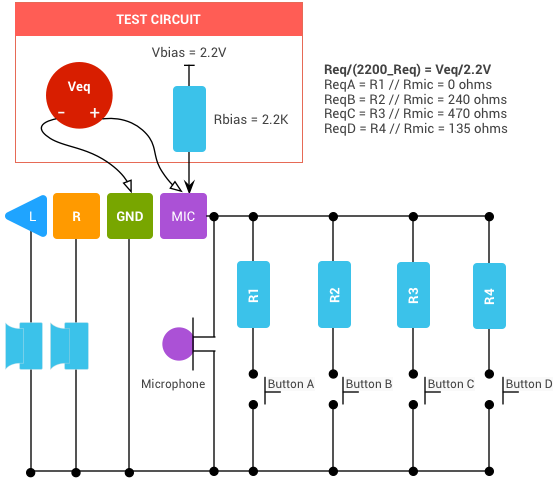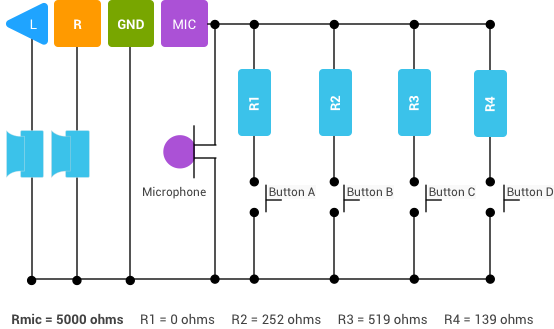บทความนี้ระบุข้อกำหนดสำหรับชุดหูฟังแบบปลั๊ก 3.5 มม. เพื่อให้ทำงานได้อย่างสม่ำเสมอในระบบนิเวศของ Android
ผู้ผลิตอุปกรณ์ควรดูข้อกำหนดเพิ่มเติมในข้อกำหนดของแจ็ค 3.5 มม. และเอกสารคำจำกัดความความเข้ากันได้ของ Android (CDD)
ฟังก์ชัน
| การทำงาน | การสนับสนุนเกี่ยวกับอุปกรณ์เสริม |
|---|---|
| เอาต์พุตเสียงสเตอริโอ | ต้องระบุ |
| อินพุตเสียง (ไมโครโฟน) | ต้องระบุ |
| การขนส่งทางบก | ต้องระบุ |
การแมปฟังก์ชันการควบคุม
| ฟังก์ชันการควบคุม | การสนับสนุนเกี่ยวกับอุปกรณ์เสริม | คำอธิบาย |
|---|---|---|
| ฟังก์ชัน ก | ต้องระบุ | เล่น/หยุดชั่วคราว/ฮุค (กดสั้นๆ), ความช่วยเหลือในการทริกเกอร์ (กดค้างไว้), ถัดไป (กด 2 ครั้ง) |
| ฟังก์ชัน ข | ไม่บังคับ | Vol+ |
| ฟังก์ชัน C | ไม่บังคับ | Vol- |
| ฟังก์ชัน D | ไม่บังคับ | สงวนไว้ (อุปกรณ์ Pixel ใช้เพื่อเปิดคำสั่งเสียง) |
กำหนดฟังก์ชันให้กับปุ่มดังนี้
- หูฟังแบบปุ่มเดียวทั้งหมดต้องใช้ฟังก์ชัน A
- ชุดหูฟังที่มีปุ่มหลายปุ่มต้องใช้ฟังก์ชันตามรูปแบบต่อไปนี้
- 2 ฟังก์ชัน: A และ D
- ฟังก์ชัน 3 รายการ ได้แก่ ก, ข และ ค
- 4 ฟังก์ชัน: A, B, C, D
เชิงกล
| การทำงาน | การสนับสนุนเกี่ยวกับอุปกรณ์เสริม | หมายเหตุ |
|---|---|---|
| ปลั๊ก 3.5 มม. 4 สาย | ต้องระบุ | ข้อมูลอ้างอิง: มาตรฐาน EIAJ-RC5325A |
| ลําดับการต่อขาของ CTIA (LRGM) | ต้องระบุ | ยกเว้นในภูมิภาคที่มีข้อกำหนดทางกฎหมายสำหรับพินเอาต์ OMTP |
| ลําดับการต่อขาของ OMTP (LRMG) | ไม่บังคับ | |
| ไมโครโฟน | ต้องระบุ | ต้องไม่มีสิ่งกีดขวางเมื่อใช้งานตัวควบคุมของชุดหูฟัง |
เกี่ยวกับไฟฟ้า
| การทำงาน | การสนับสนุนเกี่ยวกับอุปกรณ์เสริม | คำอธิบาย |
|---|---|---|
| ความต้านทานของลำโพงในหู | 16 โอห์มขึ้นไป | แนะนำ 32 - 300 โอห์ม |
| ความต้านทาน DC ของไมโครโฟน | 1,000 โอห์มขึ้นไป | ลักษณะของไมโครโฟนต้องเป็นไปตามส่วนที่ 5.4 การบันทึกเสียงของCDD ของ Android ฉบับปัจจุบัน |
| ค่าอิมพีแดนซ์ที่เทียบเท่าของฟังก์ชันควบคุม* | 0 โอห์ม | [ฟังก์ชัน A] เล่น/หยุดชั่วคราว/ฮุค |
| ความต้านทาน 240 โอห์ม +/- 1% | [ฟังก์ชัน ข] | |
| ความต้านทาน 470 โอห์ม +/- 1% | [Function C] | |
| ความต้านทาน 135 โอห์ม +/- 1% | [ฟังก์ชัน D] |
*อิมพีแดนซ์ทั้งหมดจากขั้วต่อไมโครโฟนบวกไปยัง GND เมื่อกดปุ่มโดยมีการใช้แรงดันไฟฟ้า 2.2 V กับไมโครโฟนผ่านตัวต้านทาน 2.2 kOhm
ในแผนภาพต่อไปนี้ ปุ่ม ก. จะแมปกับฟังก์ชัน ก. ปุ่ม ข. จะแมปกับฟังก์ชัน ข. และอื่นๆ
วงจรทดสอบชุดหูฟังอ้างอิง
แผนภาพต่อไปนี้สำหรับวงจรทดสอบชุดหูฟังอ้างอิง 1 แสดงการต่อสาย CTIA สำหรับปลั๊ก 4 ส่วน สําหรับการต่อสาย OMTP ให้สลับตําแหน่งของส่วน MIC และ GND

รูปที่ 1 วงจรทดสอบชุดหูฟังอ้างอิง 1
แผนภาพต่อไปนี้สำหรับวงจรทดสอบชุดหูฟังอ้างอิง 2 แสดงวิธีปรับเปลี่ยนค่าตัวต้านทานจริง (R1 - R4) เพื่อให้เป็นไปตามข้อกำหนดนี้

รูปที่ 2 วงจรทดสอบชุดหูฟังอ้างอิง 2
ความต้านทานจริงของปุ่มที่ขนานกับไมโครโฟน (R1-R4) จะขึ้นอยู่กับความต้านทานของแคปซูลไมโครโฟน (Rmic) และค่าอิมพีแดนซ์ที่เทียบเท่า (ReqA-ReqD) ใช้สูตรต่อไปนี้
ReqN=(Rmic*Rn)/(Rmic+Rn)
โดยที่ Rn คือความต้านทานจริงของปุ่ม ReqN คือค่าความต้านทานไฟฟ้าที่เทียบเท่าของปุ่มนั้น (ระบุไว้) และ Rmic คือค่าความต้านทานไฟฟ้าของไมโครโฟน
ตัวอย่างข้างต้นใช้อิมพีแดนซ์ของไมโครโฟน (Rmic) ที่ 5 kohm หากต้องการอิมพีแดนซ์ R4 ที่เทียบเท่า 135 โอห์ม (ReqD) ค่าตัวต้านทานจริง (R4) ต้องเท่ากับ 139 โอห์ม

